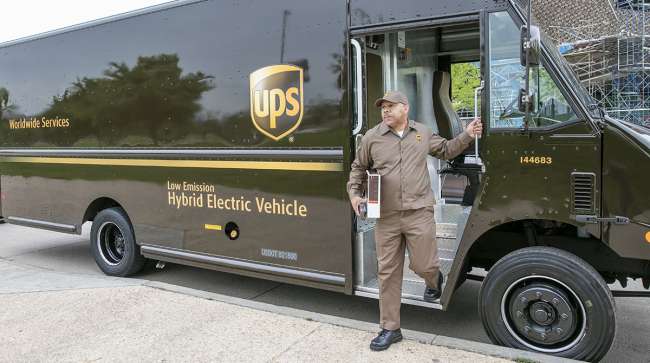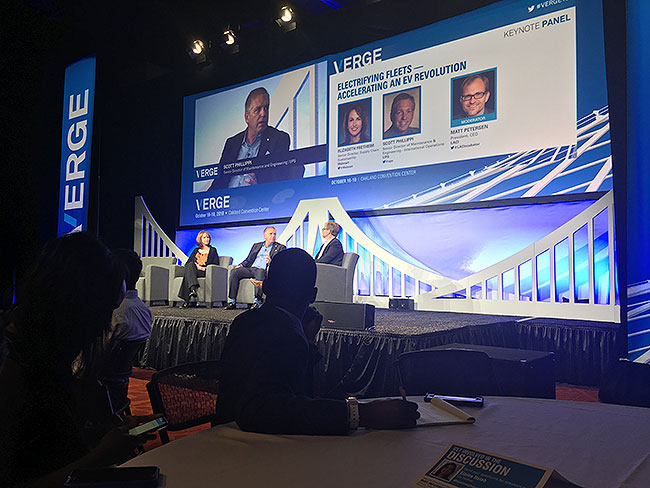UPS, Walmart Find Electric Vehicles Offer Benefits, Opportunities

OAKLAND, Calif. — Representatives from UPS Inc. and Walmart Inc., two of the country’s largest fleets, said electric vehicles can provide environmental, economic and community benefits, which make efforts to work through challenges surrounding duty cycle, charging infrastructure and cost worthwhile.
Scott Phillippi, senior director of automotive maintenance and engineering for UPS, and Elizabeth Fretheim, senior director of supply chain sustainability for Walmart, made the comments here while speaking at the GreenBiz Verge Conference.
RELATED: Collaboration Needed for Electric Vehicles to Thrive, Experts Say
“Right now there are definitely a lot of challenges we’re working through,” Fretheim said, noting that Walmart is working with several providers. “We have one truck running in Ottawa, Kansas, and have been piloting a truck in California as well.”

Elizabeth Fretheim, Scott Phillippi and Matt Petersen. (UPS Inc.)
Phillippi said the challenges of cost and infrastructure requirements can be daunting, but UPS, which is based in Atlanta and ranks No. 1 on the Transport Topics Top 100 list of the largest for-hire carriers in North America, has begun to see solutions emerge.
In the U.S., UPS recently ordered 50 electric-powered delivery trucks that the fleet anticipates will be at cost parity with conventional diesel-powered vehicles. UPS’ largest example of electric vehicle adoption is in London, where it has rolled out a smart grid project through a collaboration between government and private organizations.
“We’re able to take advantage of the power available to the facility and meter it according to what the energy needs are,” Phillippi said.
Determining power needs versus assuming each vehicle requires maximum charge allowed UPS to increase the number of electric vehicles that could be used at one of its facilities to 170 to 200 from 65. “Now I don’t have to wonder if we do all go all-electric will we have the power,” Phillippi said.
RELATED: UPS, Seattle to Launch eBike Downtown Delivery Program
For Walmart, which is based in Bentonville, Ark., and ranks No. 3 on the Transport Topics Top 100 list of the largest private carriers in North America, the over-the-road application of electric vehicles will be the most difficult. That is especially true in the early years, with the most significant challenge being charging infrastructure, Fretheim said.
“Because of our duty cycle, our fleet doesn’t go out and come back to the same location,” she said. “It is very difficult for us to say put a charging station here because our trucks are always going to pass that point.”
The lack of standards is also a concern. “We don’t have the space to put up a different charging station for each OEM that comes onto our property, and we want to make sure when we’re working with our partners, like UPS and other carriers, that when they come to our lots, they can also charge,” Fretheim said.
Initially, Fretheim said, Walmart is focusing on applications beyond over-the-road vehicles. Yard trucks that stay on distribution center property, standby reefers and auxiliary power units are all potential options for electrification.

In our third episode of RoadSigns, we ask: Will your next truck be a plug-in? Hear a snippet from Mike Roeth, executive director of the North American Council for Freight Efficiency, above, and get the full program by going to RoadSigns.TTNews.com.
“I think we need to think out of the box with these technologies and look throughout our application and see where they can be applied to our operation today and then continue to work on longer range opportunities,” she said.
Fretheim said Walmart is also exploring use electric vehicles in its fleet of passenger vehicles driven by market managers, safety managers and facility maintenance employees. “For some of those vehicles we have all-electric in place,” she said.
Getting buy-in from within the organization also takes time. Internally, Walmart has worked to get its fleet managers, maintenance team and finance group to look at a total vehicle cost rather than the traditional return on investment model, Fretheim said. “I think when we can get a total cost of ownership model everyone can believe in, there are still unknowns,” she said. “How long will batteries last? Will we get the 300 miles? I think once we can put that together we will get the buy-in we’ll need.”
Both Fretheim and Phillippi said electric vehicles create new opportunities. “It’s not necessarily just about maintenance cost reduction and fuel savings. Maybe there is a value to being able to deliver in the evening,” Phillippi said.
Within Walmart’s retail network, several Walmart stores can’t accept deliveries at night due to noise ordinance restrictions. If the company were using quieter equipment, it could shift delivery times, which could allow drivers to hit the road at different times of the day and avoid congestion, Fretheim said.
Phillippi said he believes fleet electrification could be transformational to how UPS does business in the future, and noted that UPS has learned something on every project and has learned that no model or simulator can duplicate the real-world scenario. “There will be problems along the way,” he said. Even still, Phillippi believes electric vehicles will be a significant part of delivery fleets in 10 years.
“We shouldn’t just be thinking about an incremental change from conventional fuel to electric but we should be thinking about a transformation change and how really to take full advantage of an electrified platform,” Phillippi said.




